Geological Observations from a Palaeolake Basin, Lamayuru, Ladakh, Northwestern Himalaya
引用次数: 1
Abstract
A well known Buddhist monastery of Lamayuru is located in a village about 128 Km West of Leh. It is situated on more than 100 m thick Late Quaternary palaeolake deposits which are surrounded by rocks of Lamayuru Formation. Geologically, the Lamayuru Formation includes the Lamayuru and Namikala flysch deposits of Triassic-Jurassic age. This Formation is composed of shales, schist and phyllites. This Lamayuru Formation forms the base and source of palaeolake deposits. In Late-Pleistocene (35 ka B.P.) the Lamayuru River was dammed due to tectonically triggered landslide and the Lamayuru palaeolake came into existence. The sedimentation in the palaeolake basin commenced at 35 ka B.P. and culminated at 1 ka B.P. The deposits of palaeolake consist of carbonaceous mud, sand, silty clay and matrix supported breccia. The palaeolake deposits are a product of complex interplay of lacustrine, fluvio-deltaic to colluvial processes. The research study shows the prevalence of glacio-lacustrine conditions during the major part of depositional history as evidenced by the dominance of varves in these deposits.喜马拉雅西北部拉达克拉玛尤汝古湖泊盆地的地质观测
一座著名的喇嘛庙位于莱赫以西128公里的一个村庄里。它位于厚度超过100米的晚第四纪古湖沉积物上,周围是拉马育如组的岩石。从地质学上讲,Lamayuru组包括三叠纪-侏罗纪的Lamayuru和Namikala复理石矿床。该地层由页岩、片岩和千枚岩组成。该组形成了古湖泊沉积的基础和来源。晚更新世(35ka B.P.),由于构造触发的滑坡,拉马尤鲁河被筑坝,拉马尤鲁古湖形成。古湖盆地的沉积始于35ka B.P.,并在1ka B.P.达到顶峰。古湖沉积物由碳质泥、砂、粉质粘土和基质支撑的角砾岩组成。古湖泊沉积物是湖泊、河流三角洲和崩积过程复杂相互作用的产物。研究表明,在沉积史的大部分时间里,冰川湖相条件普遍存在,这些沉积物中的变化占主导地位就证明了这一点。
本文章由计算机程序翻译,如有差异,请以英文原文为准。
求助全文
约1分钟内获得全文
求助全文

 求助内容:
求助内容: 应助结果提醒方式:
应助结果提醒方式:


